Project Report: Analyzing Tesco's CSR for Business Performance
VerifiedAdded on 2020/09/08
|19
|5240
|287
Report
AI Summary
This report analyzes a business project focused on Tesco's corporate social responsibility (CSR) initiatives. It begins with an introduction to project management and the aims and objectives of the project, emphasizing the importance of strategic planning and SMART objectives for achieving business goals. The report then details a project management plan, including cost, time, scope, quality, communication, risk, and resource management. A Gantt chart and breakdown structure are presented, followed by an exploration of both quantitative and qualitative research methods used for data collection, such as interviews, focus groups, and surveys. The report outlines research and data analysis techniques, providing appropriate suggestions based on the findings and highlighting the value of research in achieving project objectives. The report concludes with a summary of findings and references.
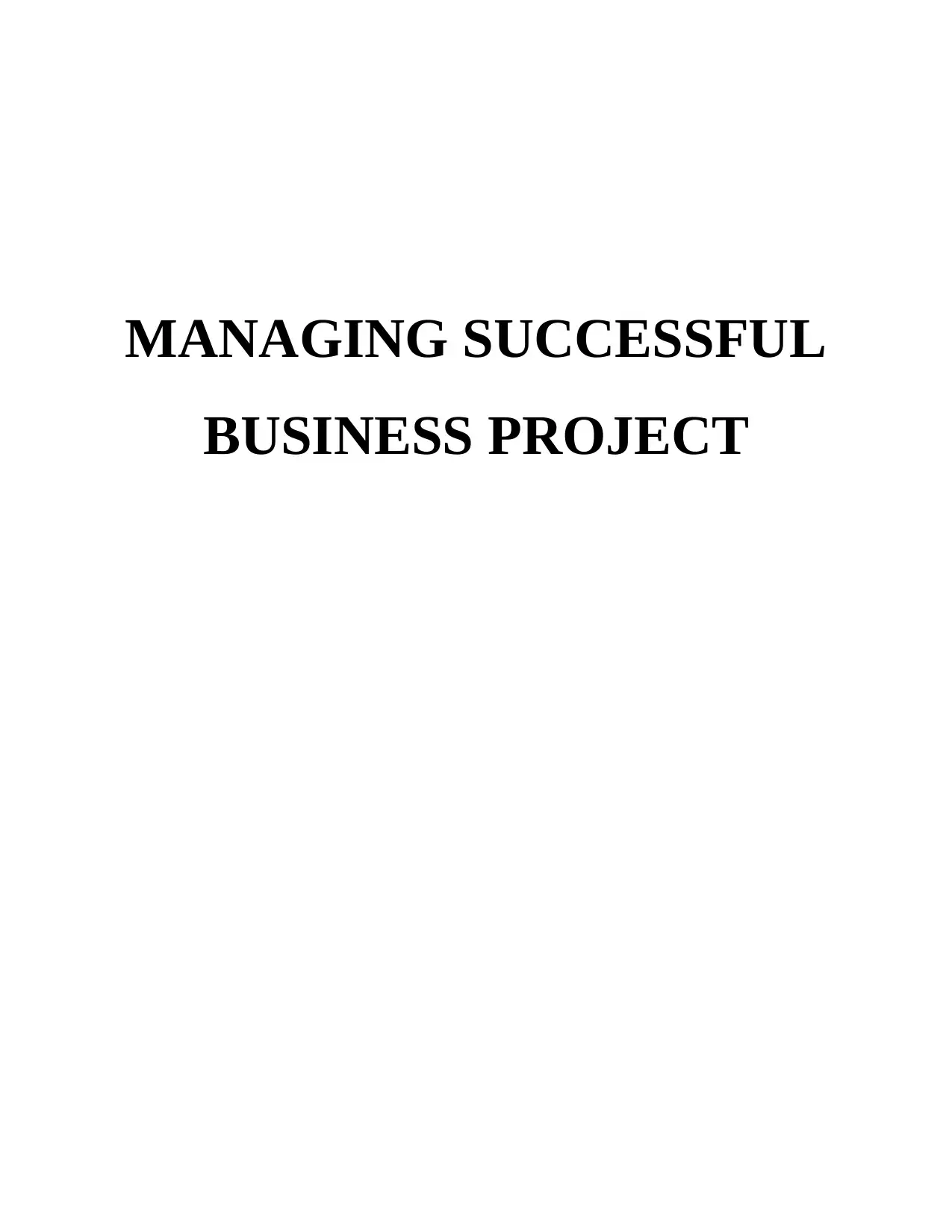
MANAGING SUCCESSFUL
BUSINESS PROJECT
BUSINESS PROJECT
Paraphrase This Document
Need a fresh take? Get an instant paraphrase of this document with our AI Paraphraser
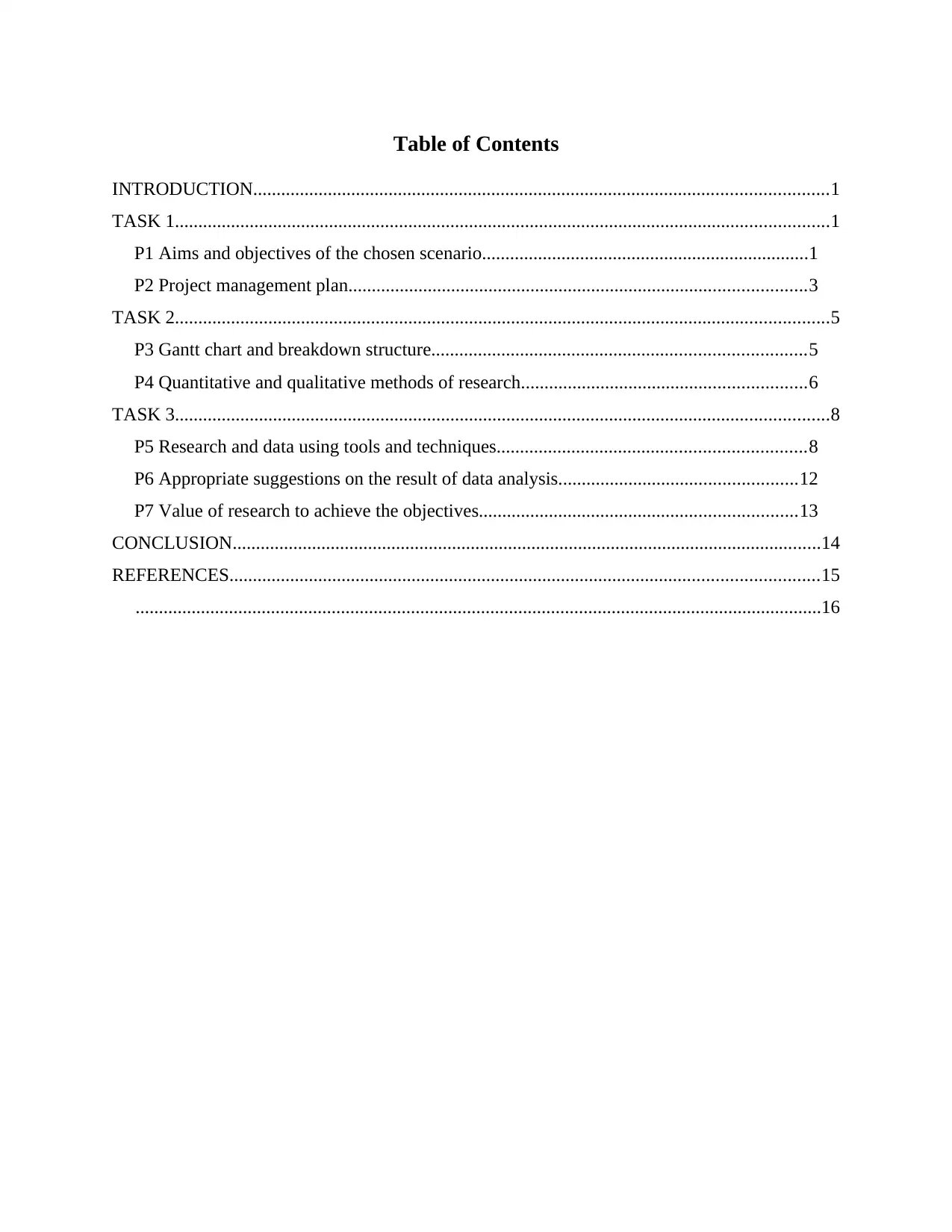
Table of Contents
INTRODUCTION...........................................................................................................................1
TASK 1............................................................................................................................................1
P1 Aims and objectives of the chosen scenario......................................................................1
P2 Project management plan..................................................................................................3
TASK 2............................................................................................................................................5
P3 Gantt chart and breakdown structure................................................................................5
P4 Quantitative and qualitative methods of research.............................................................6
TASK 3............................................................................................................................................8
P5 Research and data using tools and techniques..................................................................8
P6 Appropriate suggestions on the result of data analysis...................................................12
P7 Value of research to achieve the objectives....................................................................13
CONCLUSION..............................................................................................................................14
REFERENCES..............................................................................................................................15
...................................................................................................................................................16
INTRODUCTION...........................................................................................................................1
TASK 1............................................................................................................................................1
P1 Aims and objectives of the chosen scenario......................................................................1
P2 Project management plan..................................................................................................3
TASK 2............................................................................................................................................5
P3 Gantt chart and breakdown structure................................................................................5
P4 Quantitative and qualitative methods of research.............................................................6
TASK 3............................................................................................................................................8
P5 Research and data using tools and techniques..................................................................8
P6 Appropriate suggestions on the result of data analysis...................................................12
P7 Value of research to achieve the objectives....................................................................13
CONCLUSION..............................................................................................................................14
REFERENCES..............................................................................................................................15
...................................................................................................................................................16

⊘ This is a preview!⊘
Do you want full access?
Subscribe today to unlock all pages.

Trusted by 1+ million students worldwide
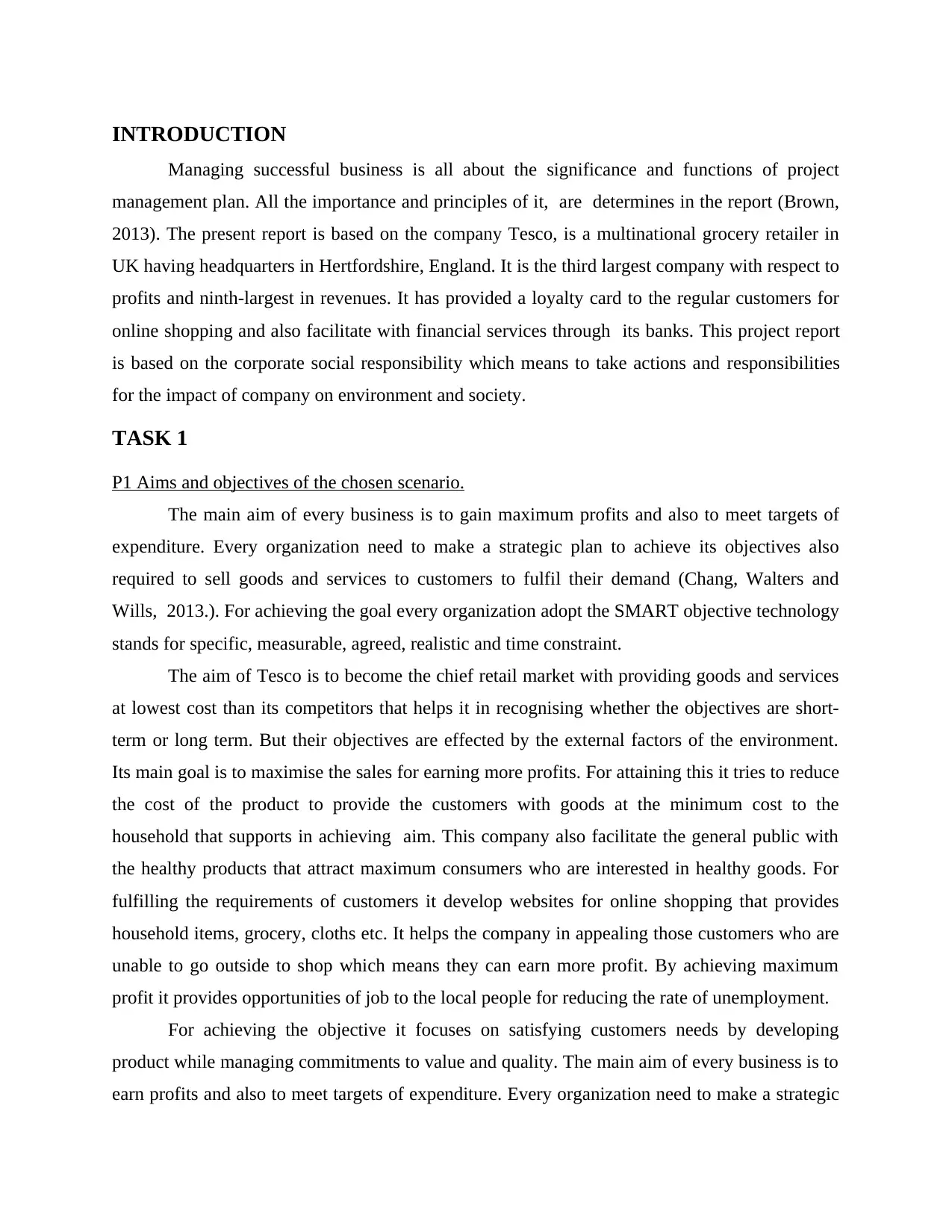
INTRODUCTION
Managing successful business is all about the significance and functions of project
management plan. All the importance and principles of it, are determines in the report (Brown,
2013). The present report is based on the company Tesco, is a multinational grocery retailer in
UK having headquarters in Hertfordshire, England. It is the third largest company with respect to
profits and ninth-largest in revenues. It has provided a loyalty card to the regular customers for
online shopping and also facilitate with financial services through its banks. This project report
is based on the corporate social responsibility which means to take actions and responsibilities
for the impact of company on environment and society.
TASK 1
P1 Aims and objectives of the chosen scenario.
The main aim of every business is to gain maximum profits and also to meet targets of
expenditure. Every organization need to make a strategic plan to achieve its objectives also
required to sell goods and services to customers to fulfil their demand (Chang, Walters and
Wills, 2013.). For achieving the goal every organization adopt the SMART objective technology
stands for specific, measurable, agreed, realistic and time constraint.
The aim of Tesco is to become the chief retail market with providing goods and services
at lowest cost than its competitors that helps it in recognising whether the objectives are short-
term or long term. But their objectives are effected by the external factors of the environment.
Its main goal is to maximise the sales for earning more profits. For attaining this it tries to reduce
the cost of the product to provide the customers with goods at the minimum cost to the
household that supports in achieving aim. This company also facilitate the general public with
the healthy products that attract maximum consumers who are interested in healthy goods. For
fulfilling the requirements of customers it develop websites for online shopping that provides
household items, grocery, cloths etc. It helps the company in appealing those customers who are
unable to go outside to shop which means they can earn more profit. By achieving maximum
profit it provides opportunities of job to the local people for reducing the rate of unemployment.
For achieving the objective it focuses on satisfying customers needs by developing
product while managing commitments to value and quality. The main aim of every business is to
earn profits and also to meet targets of expenditure. Every organization need to make a strategic
Managing successful business is all about the significance and functions of project
management plan. All the importance and principles of it, are determines in the report (Brown,
2013). The present report is based on the company Tesco, is a multinational grocery retailer in
UK having headquarters in Hertfordshire, England. It is the third largest company with respect to
profits and ninth-largest in revenues. It has provided a loyalty card to the regular customers for
online shopping and also facilitate with financial services through its banks. This project report
is based on the corporate social responsibility which means to take actions and responsibilities
for the impact of company on environment and society.
TASK 1
P1 Aims and objectives of the chosen scenario.
The main aim of every business is to gain maximum profits and also to meet targets of
expenditure. Every organization need to make a strategic plan to achieve its objectives also
required to sell goods and services to customers to fulfil their demand (Chang, Walters and
Wills, 2013.). For achieving the goal every organization adopt the SMART objective technology
stands for specific, measurable, agreed, realistic and time constraint.
The aim of Tesco is to become the chief retail market with providing goods and services
at lowest cost than its competitors that helps it in recognising whether the objectives are short-
term or long term. But their objectives are effected by the external factors of the environment.
Its main goal is to maximise the sales for earning more profits. For attaining this it tries to reduce
the cost of the product to provide the customers with goods at the minimum cost to the
household that supports in achieving aim. This company also facilitate the general public with
the healthy products that attract maximum consumers who are interested in healthy goods. For
fulfilling the requirements of customers it develop websites for online shopping that provides
household items, grocery, cloths etc. It helps the company in appealing those customers who are
unable to go outside to shop which means they can earn more profit. By achieving maximum
profit it provides opportunities of job to the local people for reducing the rate of unemployment.
For achieving the objective it focuses on satisfying customers needs by developing
product while managing commitments to value and quality. The main aim of every business is to
earn profits and also to meet targets of expenditure. Every organization need to make a strategic
Paraphrase This Document
Need a fresh take? Get an instant paraphrase of this document with our AI Paraphraser
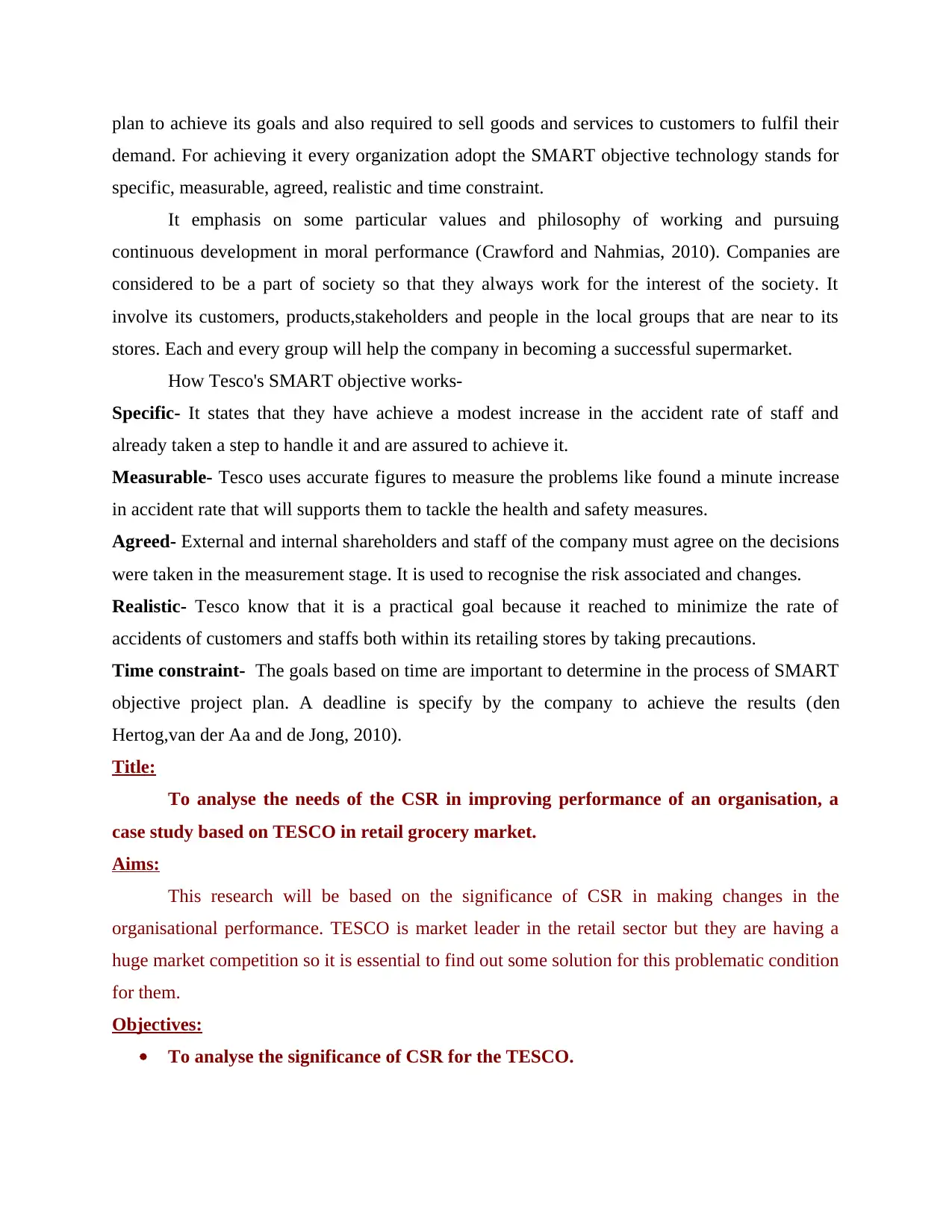
plan to achieve its goals and also required to sell goods and services to customers to fulfil their
demand. For achieving it every organization adopt the SMART objective technology stands for
specific, measurable, agreed, realistic and time constraint.
It emphasis on some particular values and philosophy of working and pursuing
continuous development in moral performance (Crawford and Nahmias, 2010). Companies are
considered to be a part of society so that they always work for the interest of the society. It
involve its customers, products,stakeholders and people in the local groups that are near to its
stores. Each and every group will help the company in becoming a successful supermarket.
How Tesco's SMART objective works-
Specific- It states that they have achieve a modest increase in the accident rate of staff and
already taken a step to handle it and are assured to achieve it.
Measurable- Tesco uses accurate figures to measure the problems like found a minute increase
in accident rate that will supports them to tackle the health and safety measures.
Agreed- External and internal shareholders and staff of the company must agree on the decisions
were taken in the measurement stage. It is used to recognise the risk associated and changes.
Realistic- Tesco know that it is a practical goal because it reached to minimize the rate of
accidents of customers and staffs both within its retailing stores by taking precautions.
Time constraint- The goals based on time are important to determine in the process of SMART
objective project plan. A deadline is specify by the company to achieve the results (den
Hertog,van der Aa and de Jong, 2010).
Title:
To analyse the needs of the CSR in improving performance of an organisation, a
case study based on TESCO in retail grocery market.
Aims:
This research will be based on the significance of CSR in making changes in the
organisational performance. TESCO is market leader in the retail sector but they are having a
huge market competition so it is essential to find out some solution for this problematic condition
for them.
Objectives:
To analyse the significance of CSR for the TESCO.
demand. For achieving it every organization adopt the SMART objective technology stands for
specific, measurable, agreed, realistic and time constraint.
It emphasis on some particular values and philosophy of working and pursuing
continuous development in moral performance (Crawford and Nahmias, 2010). Companies are
considered to be a part of society so that they always work for the interest of the society. It
involve its customers, products,stakeholders and people in the local groups that are near to its
stores. Each and every group will help the company in becoming a successful supermarket.
How Tesco's SMART objective works-
Specific- It states that they have achieve a modest increase in the accident rate of staff and
already taken a step to handle it and are assured to achieve it.
Measurable- Tesco uses accurate figures to measure the problems like found a minute increase
in accident rate that will supports them to tackle the health and safety measures.
Agreed- External and internal shareholders and staff of the company must agree on the decisions
were taken in the measurement stage. It is used to recognise the risk associated and changes.
Realistic- Tesco know that it is a practical goal because it reached to minimize the rate of
accidents of customers and staffs both within its retailing stores by taking precautions.
Time constraint- The goals based on time are important to determine in the process of SMART
objective project plan. A deadline is specify by the company to achieve the results (den
Hertog,van der Aa and de Jong, 2010).
Title:
To analyse the needs of the CSR in improving performance of an organisation, a
case study based on TESCO in retail grocery market.
Aims:
This research will be based on the significance of CSR in making changes in the
organisational performance. TESCO is market leader in the retail sector but they are having a
huge market competition so it is essential to find out some solution for this problematic condition
for them.
Objectives:
To analyse the significance of CSR for the TESCO.
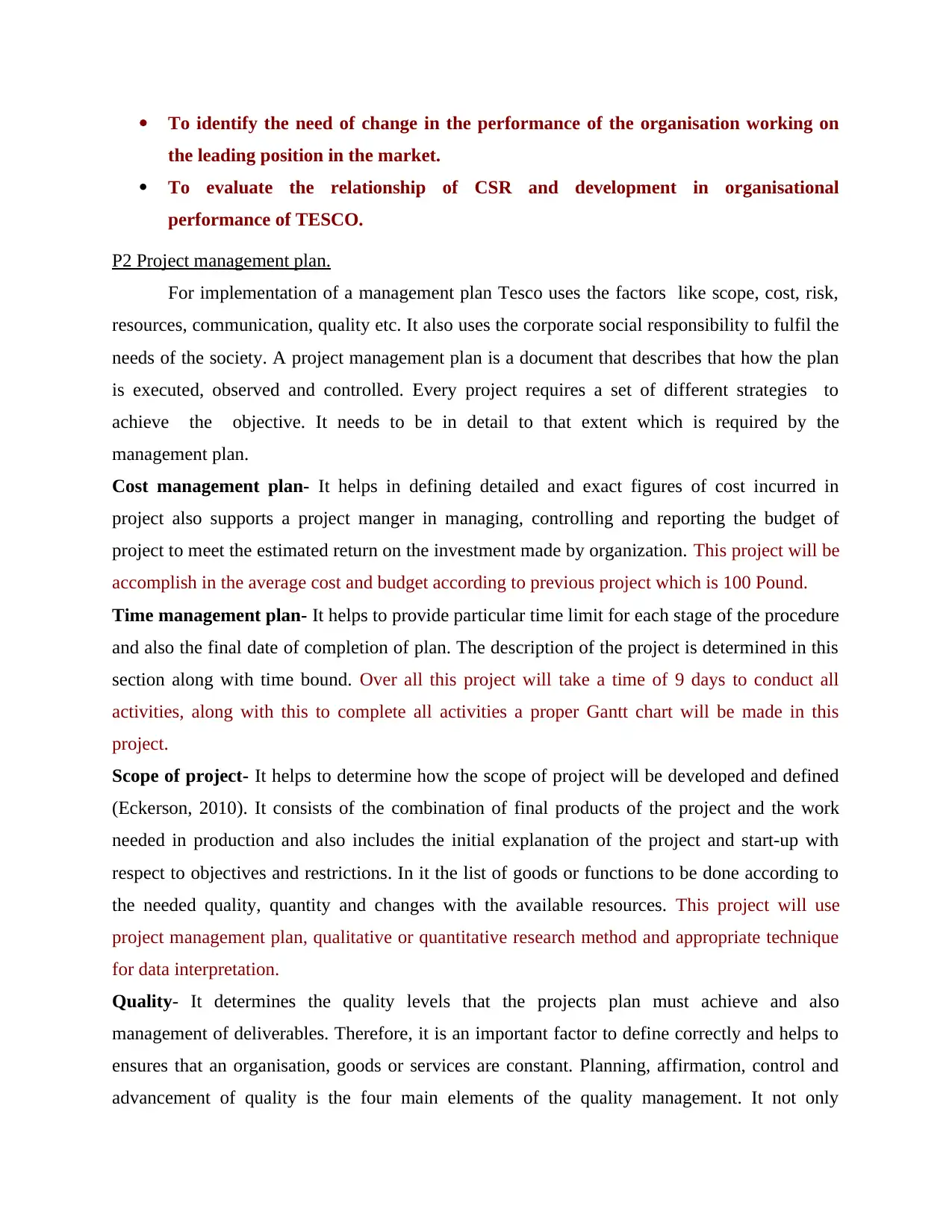
To identify the need of change in the performance of the organisation working on
the leading position in the market.
To evaluate the relationship of CSR and development in organisational
performance of TESCO.
P2 Project management plan.
For implementation of a management plan Tesco uses the factors like scope, cost, risk,
resources, communication, quality etc. It also uses the corporate social responsibility to fulfil the
needs of the society. A project management plan is a document that describes that how the plan
is executed, observed and controlled. Every project requires a set of different strategies to
achieve the objective. It needs to be in detail to that extent which is required by the
management plan.
Cost management plan- It helps in defining detailed and exact figures of cost incurred in
project also supports a project manger in managing, controlling and reporting the budget of
project to meet the estimated return on the investment made by organization. This project will be
accomplish in the average cost and budget according to previous project which is 100 Pound.
Time management plan- It helps to provide particular time limit for each stage of the procedure
and also the final date of completion of plan. The description of the project is determined in this
section along with time bound. Over all this project will take a time of 9 days to conduct all
activities, along with this to complete all activities a proper Gantt chart will be made in this
project.
Scope of project- It helps to determine how the scope of project will be developed and defined
(Eckerson, 2010). It consists of the combination of final products of the project and the work
needed in production and also includes the initial explanation of the project and start-up with
respect to objectives and restrictions. In it the list of goods or functions to be done according to
the needed quality, quantity and changes with the available resources. This project will use
project management plan, qualitative or quantitative research method and appropriate technique
for data interpretation.
Quality- It determines the quality levels that the projects plan must achieve and also
management of deliverables. Therefore, it is an important factor to define correctly and helps to
ensures that an organisation, goods or services are constant. Planning, affirmation, control and
advancement of quality is the four main elements of the quality management. It not only
the leading position in the market.
To evaluate the relationship of CSR and development in organisational
performance of TESCO.
P2 Project management plan.
For implementation of a management plan Tesco uses the factors like scope, cost, risk,
resources, communication, quality etc. It also uses the corporate social responsibility to fulfil the
needs of the society. A project management plan is a document that describes that how the plan
is executed, observed and controlled. Every project requires a set of different strategies to
achieve the objective. It needs to be in detail to that extent which is required by the
management plan.
Cost management plan- It helps in defining detailed and exact figures of cost incurred in
project also supports a project manger in managing, controlling and reporting the budget of
project to meet the estimated return on the investment made by organization. This project will be
accomplish in the average cost and budget according to previous project which is 100 Pound.
Time management plan- It helps to provide particular time limit for each stage of the procedure
and also the final date of completion of plan. The description of the project is determined in this
section along with time bound. Over all this project will take a time of 9 days to conduct all
activities, along with this to complete all activities a proper Gantt chart will be made in this
project.
Scope of project- It helps to determine how the scope of project will be developed and defined
(Eckerson, 2010). It consists of the combination of final products of the project and the work
needed in production and also includes the initial explanation of the project and start-up with
respect to objectives and restrictions. In it the list of goods or functions to be done according to
the needed quality, quantity and changes with the available resources. This project will use
project management plan, qualitative or quantitative research method and appropriate technique
for data interpretation.
Quality- It determines the quality levels that the projects plan must achieve and also
management of deliverables. Therefore, it is an important factor to define correctly and helps to
ensures that an organisation, goods or services are constant. Planning, affirmation, control and
advancement of quality is the four main elements of the quality management. It not only
⊘ This is a preview!⊘
Do you want full access?
Subscribe today to unlock all pages.

Trusted by 1+ million students worldwide
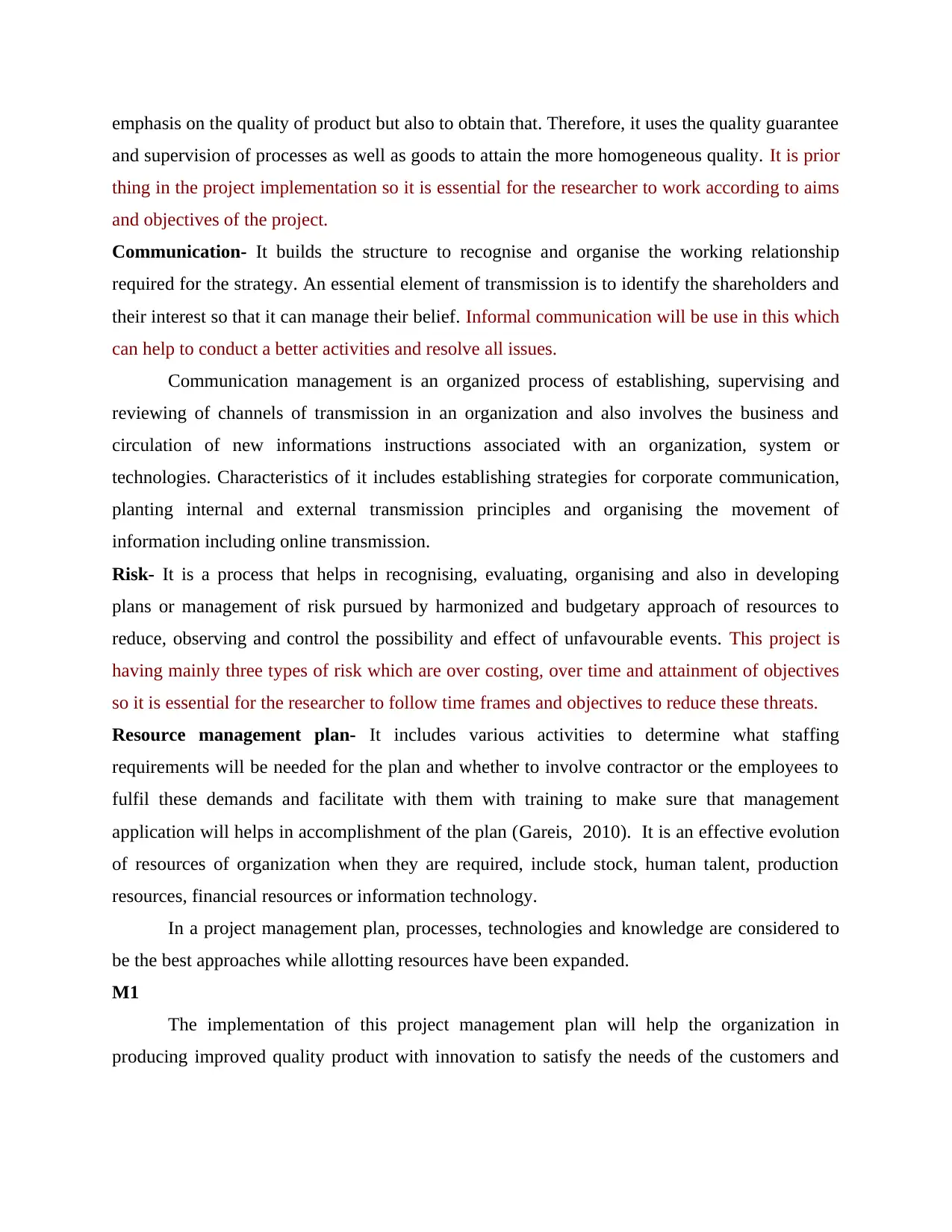
emphasis on the quality of product but also to obtain that. Therefore, it uses the quality guarantee
and supervision of processes as well as goods to attain the more homogeneous quality. It is prior
thing in the project implementation so it is essential for the researcher to work according to aims
and objectives of the project.
Communication- It builds the structure to recognise and organise the working relationship
required for the strategy. An essential element of transmission is to identify the shareholders and
their interest so that it can manage their belief. Informal communication will be use in this which
can help to conduct a better activities and resolve all issues.
Communication management is an organized process of establishing, supervising and
reviewing of channels of transmission in an organization and also involves the business and
circulation of new informations instructions associated with an organization, system or
technologies. Characteristics of it includes establishing strategies for corporate communication,
planting internal and external transmission principles and organising the movement of
information including online transmission.
Risk- It is a process that helps in recognising, evaluating, organising and also in developing
plans or management of risk pursued by harmonized and budgetary approach of resources to
reduce, observing and control the possibility and effect of unfavourable events. This project is
having mainly three types of risk which are over costing, over time and attainment of objectives
so it is essential for the researcher to follow time frames and objectives to reduce these threats.
Resource management plan- It includes various activities to determine what staffing
requirements will be needed for the plan and whether to involve contractor or the employees to
fulfil these demands and facilitate with them with training to make sure that management
application will helps in accomplishment of the plan (Gareis, 2010). It is an effective evolution
of resources of organization when they are required, include stock, human talent, production
resources, financial resources or information technology.
In a project management plan, processes, technologies and knowledge are considered to
be the best approaches while allotting resources have been expanded.
M1
The implementation of this project management plan will help the organization in
producing improved quality product with innovation to satisfy the needs of the customers and
and supervision of processes as well as goods to attain the more homogeneous quality. It is prior
thing in the project implementation so it is essential for the researcher to work according to aims
and objectives of the project.
Communication- It builds the structure to recognise and organise the working relationship
required for the strategy. An essential element of transmission is to identify the shareholders and
their interest so that it can manage their belief. Informal communication will be use in this which
can help to conduct a better activities and resolve all issues.
Communication management is an organized process of establishing, supervising and
reviewing of channels of transmission in an organization and also involves the business and
circulation of new informations instructions associated with an organization, system or
technologies. Characteristics of it includes establishing strategies for corporate communication,
planting internal and external transmission principles and organising the movement of
information including online transmission.
Risk- It is a process that helps in recognising, evaluating, organising and also in developing
plans or management of risk pursued by harmonized and budgetary approach of resources to
reduce, observing and control the possibility and effect of unfavourable events. This project is
having mainly three types of risk which are over costing, over time and attainment of objectives
so it is essential for the researcher to follow time frames and objectives to reduce these threats.
Resource management plan- It includes various activities to determine what staffing
requirements will be needed for the plan and whether to involve contractor or the employees to
fulfil these demands and facilitate with them with training to make sure that management
application will helps in accomplishment of the plan (Gareis, 2010). It is an effective evolution
of resources of organization when they are required, include stock, human talent, production
resources, financial resources or information technology.
In a project management plan, processes, technologies and knowledge are considered to
be the best approaches while allotting resources have been expanded.
M1
The implementation of this project management plan will help the organization in
producing improved quality product with innovation to satisfy the needs of the customers and
Paraphrase This Document
Need a fresh take? Get an instant paraphrase of this document with our AI Paraphraser
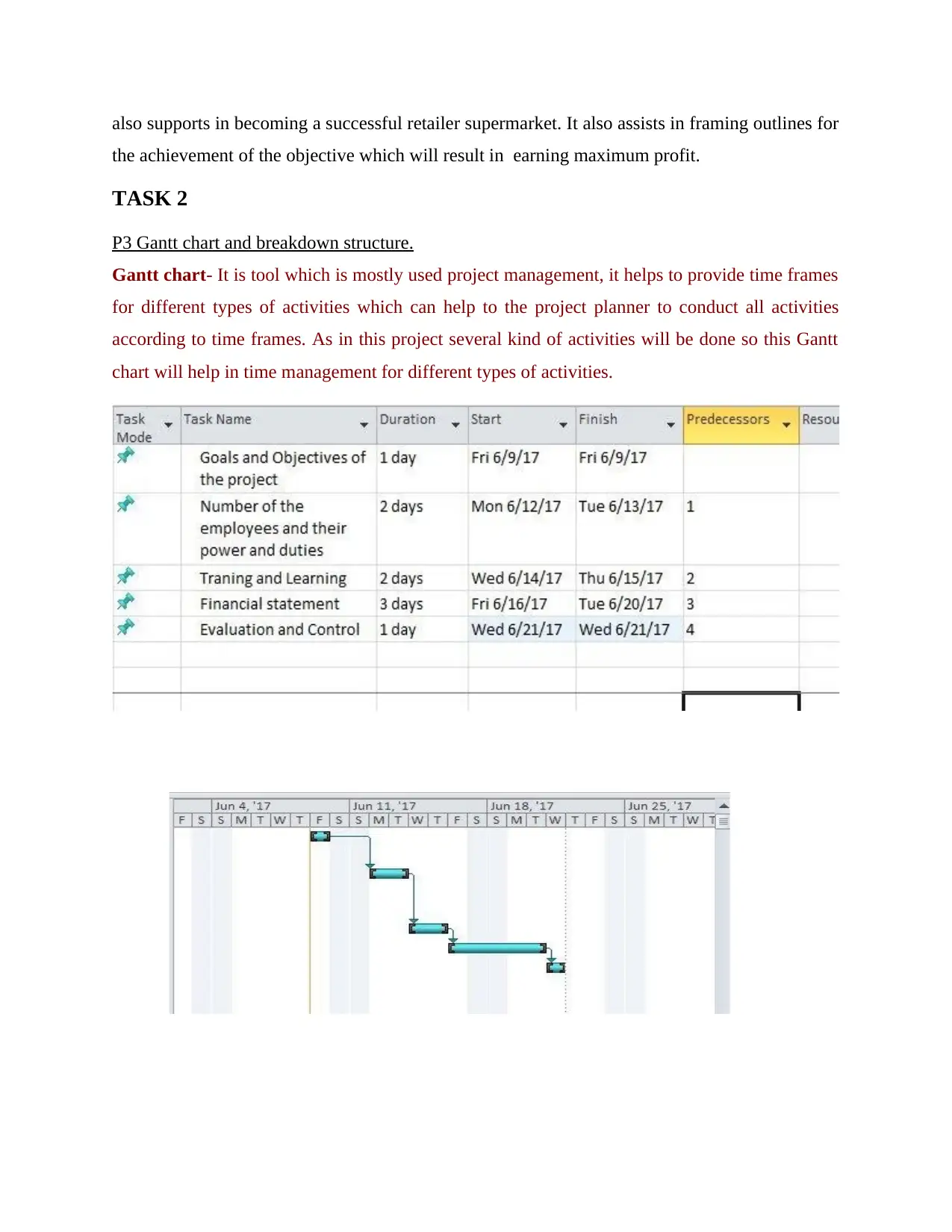
also supports in becoming a successful retailer supermarket. It also assists in framing outlines for
the achievement of the objective which will result in earning maximum profit.
TASK 2
P3 Gantt chart and breakdown structure.
Gantt chart- It is tool which is mostly used project management, it helps to provide time frames
for different types of activities which can help to the project planner to conduct all activities
according to time frames. As in this project several kind of activities will be done so this Gantt
chart will help in time management for different types of activities.
the achievement of the objective which will result in earning maximum profit.
TASK 2
P3 Gantt chart and breakdown structure.
Gantt chart- It is tool which is mostly used project management, it helps to provide time frames
for different types of activities which can help to the project planner to conduct all activities
according to time frames. As in this project several kind of activities will be done so this Gantt
chart will help in time management for different types of activities.
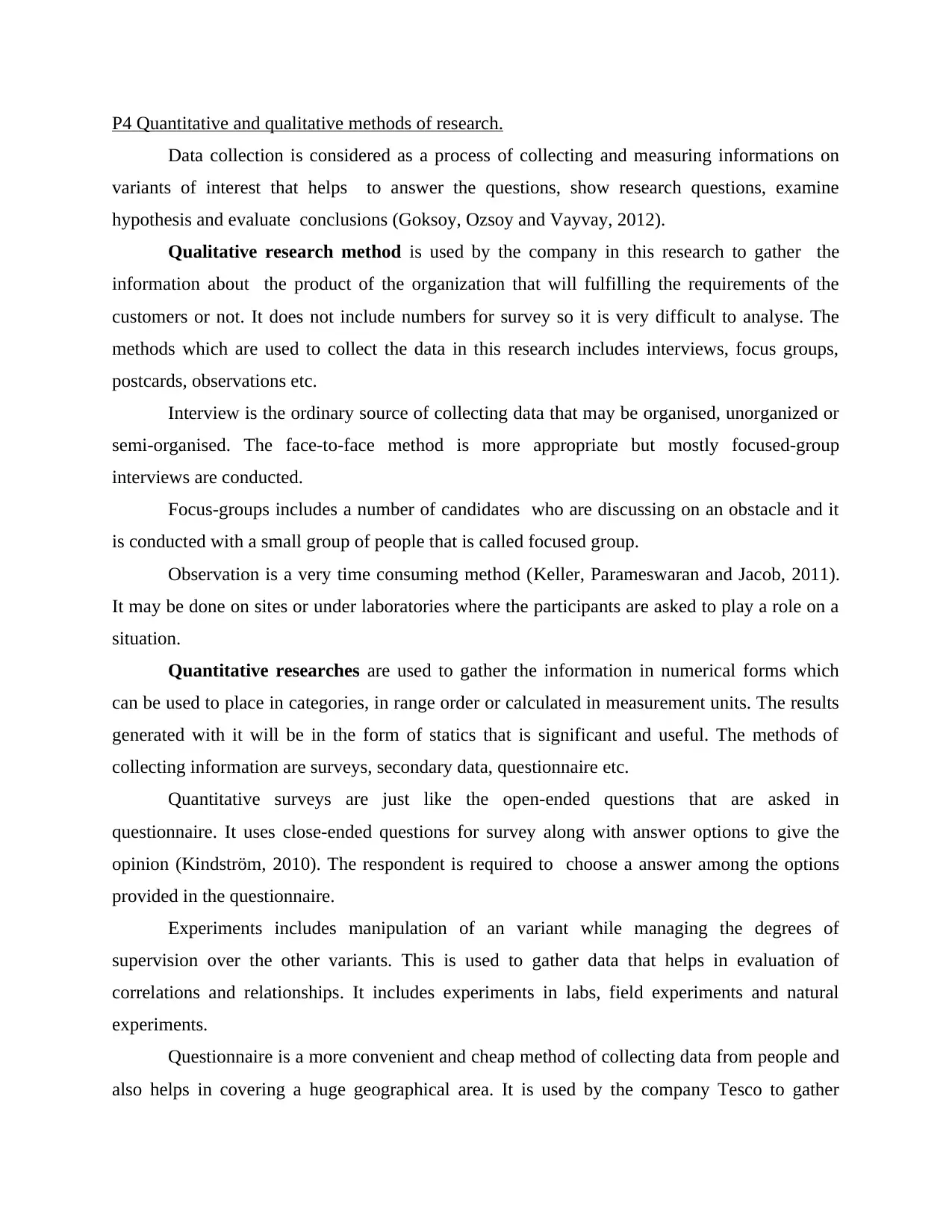
P4 Quantitative and qualitative methods of research.
Data collection is considered as a process of collecting and measuring informations on
variants of interest that helps to answer the questions, show research questions, examine
hypothesis and evaluate conclusions (Goksoy, Ozsoy and Vayvay, 2012).
Qualitative research method is used by the company in this research to gather the
information about the product of the organization that will fulfilling the requirements of the
customers or not. It does not include numbers for survey so it is very difficult to analyse. The
methods which are used to collect the data in this research includes interviews, focus groups,
postcards, observations etc.
Interview is the ordinary source of collecting data that may be organised, unorganized or
semi-organised. The face-to-face method is more appropriate but mostly focused-group
interviews are conducted.
Focus-groups includes a number of candidates who are discussing on an obstacle and it
is conducted with a small group of people that is called focused group.
Observation is a very time consuming method (Keller, Parameswaran and Jacob, 2011).
It may be done on sites or under laboratories where the participants are asked to play a role on a
situation.
Quantitative researches are used to gather the information in numerical forms which
can be used to place in categories, in range order or calculated in measurement units. The results
generated with it will be in the form of statics that is significant and useful. The methods of
collecting information are surveys, secondary data, questionnaire etc.
Quantitative surveys are just like the open-ended questions that are asked in
questionnaire. It uses close-ended questions for survey along with answer options to give the
opinion (Kindström, 2010). The respondent is required to choose a answer among the options
provided in the questionnaire.
Experiments includes manipulation of an variant while managing the degrees of
supervision over the other variants. This is used to gather data that helps in evaluation of
correlations and relationships. It includes experiments in labs, field experiments and natural
experiments.
Questionnaire is a more convenient and cheap method of collecting data from people and
also helps in covering a huge geographical area. It is used by the company Tesco to gather
Data collection is considered as a process of collecting and measuring informations on
variants of interest that helps to answer the questions, show research questions, examine
hypothesis and evaluate conclusions (Goksoy, Ozsoy and Vayvay, 2012).
Qualitative research method is used by the company in this research to gather the
information about the product of the organization that will fulfilling the requirements of the
customers or not. It does not include numbers for survey so it is very difficult to analyse. The
methods which are used to collect the data in this research includes interviews, focus groups,
postcards, observations etc.
Interview is the ordinary source of collecting data that may be organised, unorganized or
semi-organised. The face-to-face method is more appropriate but mostly focused-group
interviews are conducted.
Focus-groups includes a number of candidates who are discussing on an obstacle and it
is conducted with a small group of people that is called focused group.
Observation is a very time consuming method (Keller, Parameswaran and Jacob, 2011).
It may be done on sites or under laboratories where the participants are asked to play a role on a
situation.
Quantitative researches are used to gather the information in numerical forms which
can be used to place in categories, in range order or calculated in measurement units. The results
generated with it will be in the form of statics that is significant and useful. The methods of
collecting information are surveys, secondary data, questionnaire etc.
Quantitative surveys are just like the open-ended questions that are asked in
questionnaire. It uses close-ended questions for survey along with answer options to give the
opinion (Kindström, 2010). The respondent is required to choose a answer among the options
provided in the questionnaire.
Experiments includes manipulation of an variant while managing the degrees of
supervision over the other variants. This is used to gather data that helps in evaluation of
correlations and relationships. It includes experiments in labs, field experiments and natural
experiments.
Questionnaire is a more convenient and cheap method of collecting data from people and
also helps in covering a huge geographical area. It is used by the company Tesco to gather
⊘ This is a preview!⊘
Do you want full access?
Subscribe today to unlock all pages.

Trusted by 1+ million students worldwide
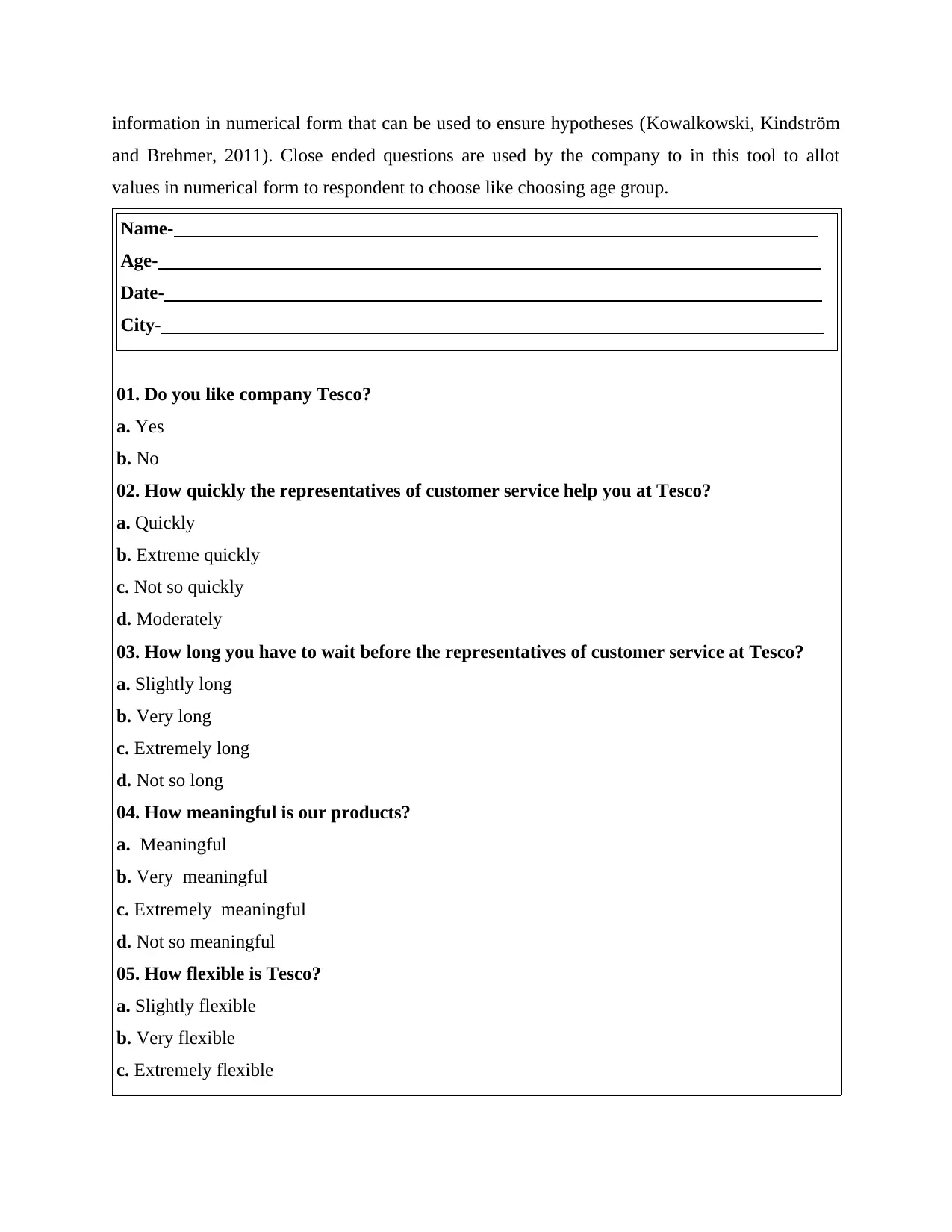
information in numerical form that can be used to ensure hypotheses (Kowalkowski, Kindström
and Brehmer, 2011). Close ended questions are used by the company to in this tool to allot
values in numerical form to respondent to choose like choosing age group.
Name-
Age-
Date-
City-
01. Do you like company Tesco?
a. Yes
b. No
02. How quickly the representatives of customer service help you at Tesco?
a. Quickly
b. Extreme quickly
c. Not so quickly
d. Moderately
03. How long you have to wait before the representatives of customer service at Tesco?
a. Slightly long
b. Very long
c. Extremely long
d. Not so long
04. How meaningful is our products?
a. Meaningful
b. Very meaningful
c. Extremely meaningful
d. Not so meaningful
05. How flexible is Tesco?
a. Slightly flexible
b. Very flexible
c. Extremely flexible
and Brehmer, 2011). Close ended questions are used by the company to in this tool to allot
values in numerical form to respondent to choose like choosing age group.
Name-
Age-
Date-
City-
01. Do you like company Tesco?
a. Yes
b. No
02. How quickly the representatives of customer service help you at Tesco?
a. Quickly
b. Extreme quickly
c. Not so quickly
d. Moderately
03. How long you have to wait before the representatives of customer service at Tesco?
a. Slightly long
b. Very long
c. Extremely long
d. Not so long
04. How meaningful is our products?
a. Meaningful
b. Very meaningful
c. Extremely meaningful
d. Not so meaningful
05. How flexible is Tesco?
a. Slightly flexible
b. Very flexible
c. Extremely flexible
Paraphrase This Document
Need a fresh take? Get an instant paraphrase of this document with our AI Paraphraser
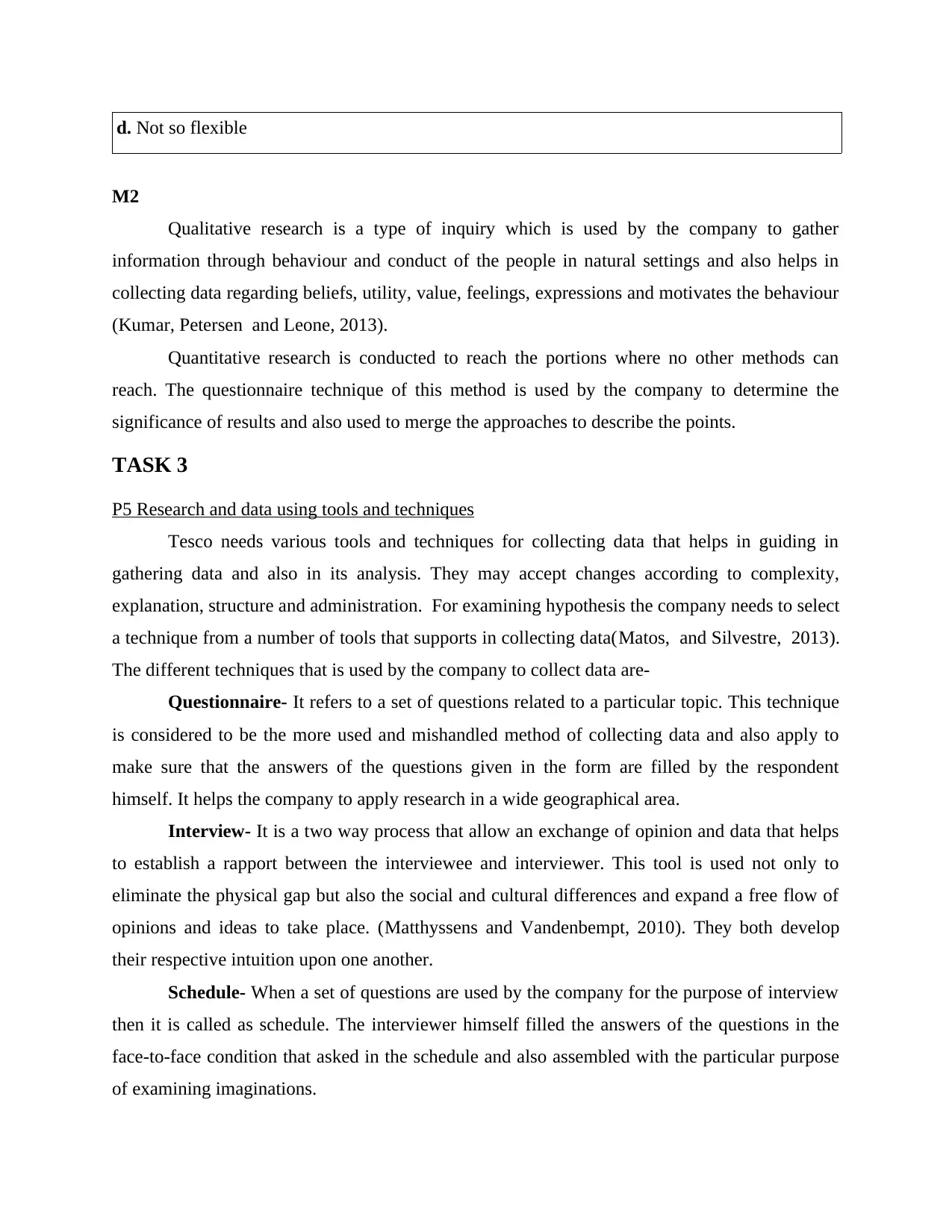
d. Not so flexible
M2
Qualitative research is a type of inquiry which is used by the company to gather
information through behaviour and conduct of the people in natural settings and also helps in
collecting data regarding beliefs, utility, value, feelings, expressions and motivates the behaviour
(Kumar, Petersen and Leone, 2013).
Quantitative research is conducted to reach the portions where no other methods can
reach. The questionnaire technique of this method is used by the company to determine the
significance of results and also used to merge the approaches to describe the points.
TASK 3
P5 Research and data using tools and techniques
Tesco needs various tools and techniques for collecting data that helps in guiding in
gathering data and also in its analysis. They may accept changes according to complexity,
explanation, structure and administration. For examining hypothesis the company needs to select
a technique from a number of tools that supports in collecting data(Matos, and Silvestre, 2013).
The different techniques that is used by the company to collect data are-
Questionnaire- It refers to a set of questions related to a particular topic. This technique
is considered to be the more used and mishandled method of collecting data and also apply to
make sure that the answers of the questions given in the form are filled by the respondent
himself. It helps the company to apply research in a wide geographical area.
Interview- It is a two way process that allow an exchange of opinion and data that helps
to establish a rapport between the interviewee and interviewer. This tool is used not only to
eliminate the physical gap but also the social and cultural differences and expand a free flow of
opinions and ideas to take place. (Matthyssens and Vandenbempt, 2010). They both develop
their respective intuition upon one another.
Schedule- When a set of questions are used by the company for the purpose of interview
then it is called as schedule. The interviewer himself filled the answers of the questions in the
face-to-face condition that asked in the schedule and also assembled with the particular purpose
of examining imaginations.
M2
Qualitative research is a type of inquiry which is used by the company to gather
information through behaviour and conduct of the people in natural settings and also helps in
collecting data regarding beliefs, utility, value, feelings, expressions and motivates the behaviour
(Kumar, Petersen and Leone, 2013).
Quantitative research is conducted to reach the portions where no other methods can
reach. The questionnaire technique of this method is used by the company to determine the
significance of results and also used to merge the approaches to describe the points.
TASK 3
P5 Research and data using tools and techniques
Tesco needs various tools and techniques for collecting data that helps in guiding in
gathering data and also in its analysis. They may accept changes according to complexity,
explanation, structure and administration. For examining hypothesis the company needs to select
a technique from a number of tools that supports in collecting data(Matos, and Silvestre, 2013).
The different techniques that is used by the company to collect data are-
Questionnaire- It refers to a set of questions related to a particular topic. This technique
is considered to be the more used and mishandled method of collecting data and also apply to
make sure that the answers of the questions given in the form are filled by the respondent
himself. It helps the company to apply research in a wide geographical area.
Interview- It is a two way process that allow an exchange of opinion and data that helps
to establish a rapport between the interviewee and interviewer. This tool is used not only to
eliminate the physical gap but also the social and cultural differences and expand a free flow of
opinions and ideas to take place. (Matthyssens and Vandenbempt, 2010). They both develop
their respective intuition upon one another.
Schedule- When a set of questions are used by the company for the purpose of interview
then it is called as schedule. The interviewer himself filled the answers of the questions in the
face-to-face condition that asked in the schedule and also assembled with the particular purpose
of examining imaginations.
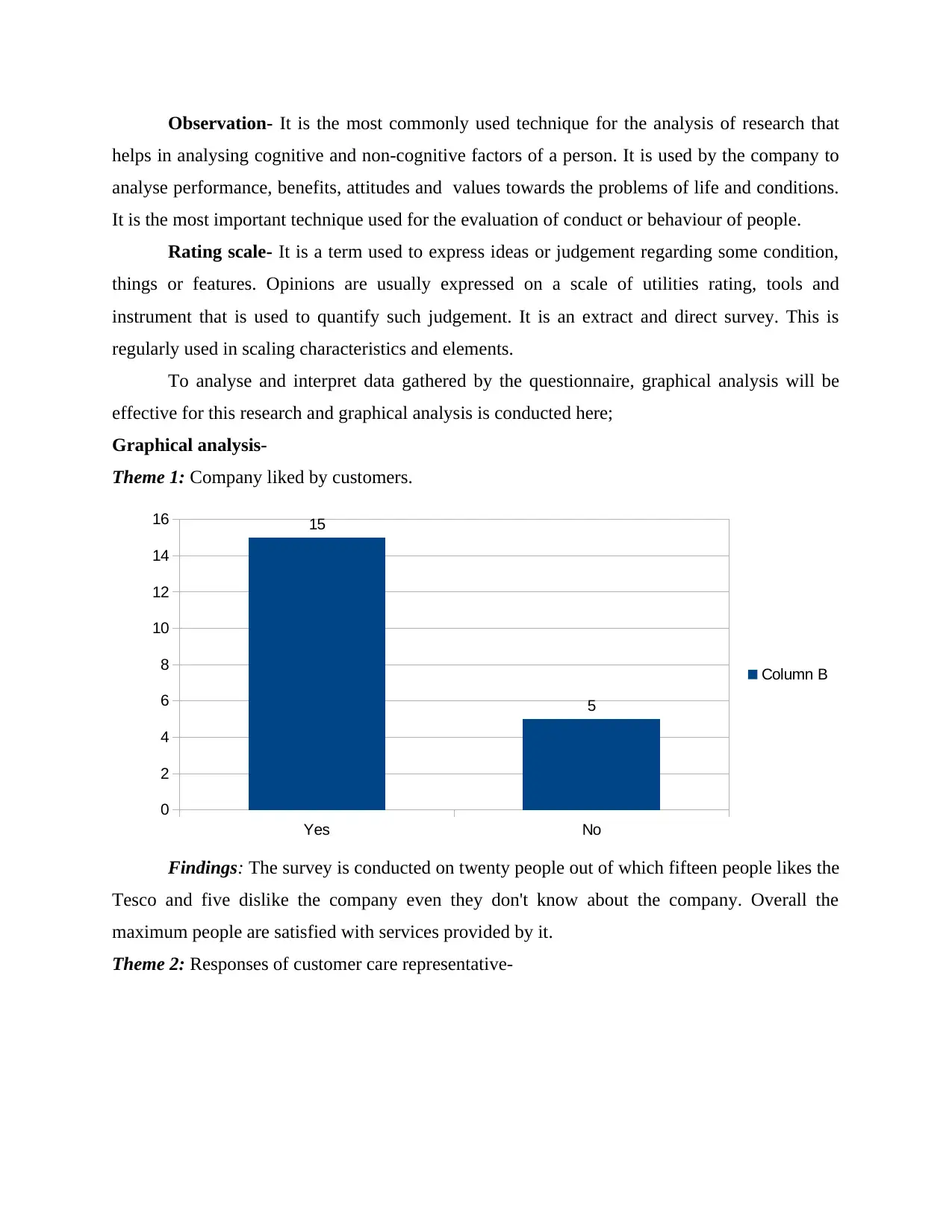
Observation- It is the most commonly used technique for the analysis of research that
helps in analysing cognitive and non-cognitive factors of a person. It is used by the company to
analyse performance, benefits, attitudes and values towards the problems of life and conditions.
It is the most important technique used for the evaluation of conduct or behaviour of people.
Rating scale- It is a term used to express ideas or judgement regarding some condition,
things or features. Opinions are usually expressed on a scale of utilities rating, tools and
instrument that is used to quantify such judgement. It is an extract and direct survey. This is
regularly used in scaling characteristics and elements.
To analyse and interpret data gathered by the questionnaire, graphical analysis will be
effective for this research and graphical analysis is conducted here;
Graphical analysis-
Theme 1: Company liked by customers.
Findings: The survey is conducted on twenty people out of which fifteen people likes the
Tesco and five dislike the company even they don't know about the company. Overall the
maximum people are satisfied with services provided by it.
Theme 2: Responses of customer care representative-
Yes No
0
2
4
6
8
10
12
14
16 15
5
Column B
helps in analysing cognitive and non-cognitive factors of a person. It is used by the company to
analyse performance, benefits, attitudes and values towards the problems of life and conditions.
It is the most important technique used for the evaluation of conduct or behaviour of people.
Rating scale- It is a term used to express ideas or judgement regarding some condition,
things or features. Opinions are usually expressed on a scale of utilities rating, tools and
instrument that is used to quantify such judgement. It is an extract and direct survey. This is
regularly used in scaling characteristics and elements.
To analyse and interpret data gathered by the questionnaire, graphical analysis will be
effective for this research and graphical analysis is conducted here;
Graphical analysis-
Theme 1: Company liked by customers.
Findings: The survey is conducted on twenty people out of which fifteen people likes the
Tesco and five dislike the company even they don't know about the company. Overall the
maximum people are satisfied with services provided by it.
Theme 2: Responses of customer care representative-
Yes No
0
2
4
6
8
10
12
14
16 15
5
Column B
⊘ This is a preview!⊘
Do you want full access?
Subscribe today to unlock all pages.

Trusted by 1+ million students worldwide
1 out of 19
Related Documents
Your All-in-One AI-Powered Toolkit for Academic Success.
+13062052269
info@desklib.com
Available 24*7 on WhatsApp / Email
![[object Object]](/_next/static/media/star-bottom.7253800d.svg)
Unlock your academic potential
Copyright © 2020–2025 A2Z Services. All Rights Reserved. Developed and managed by ZUCOL.




